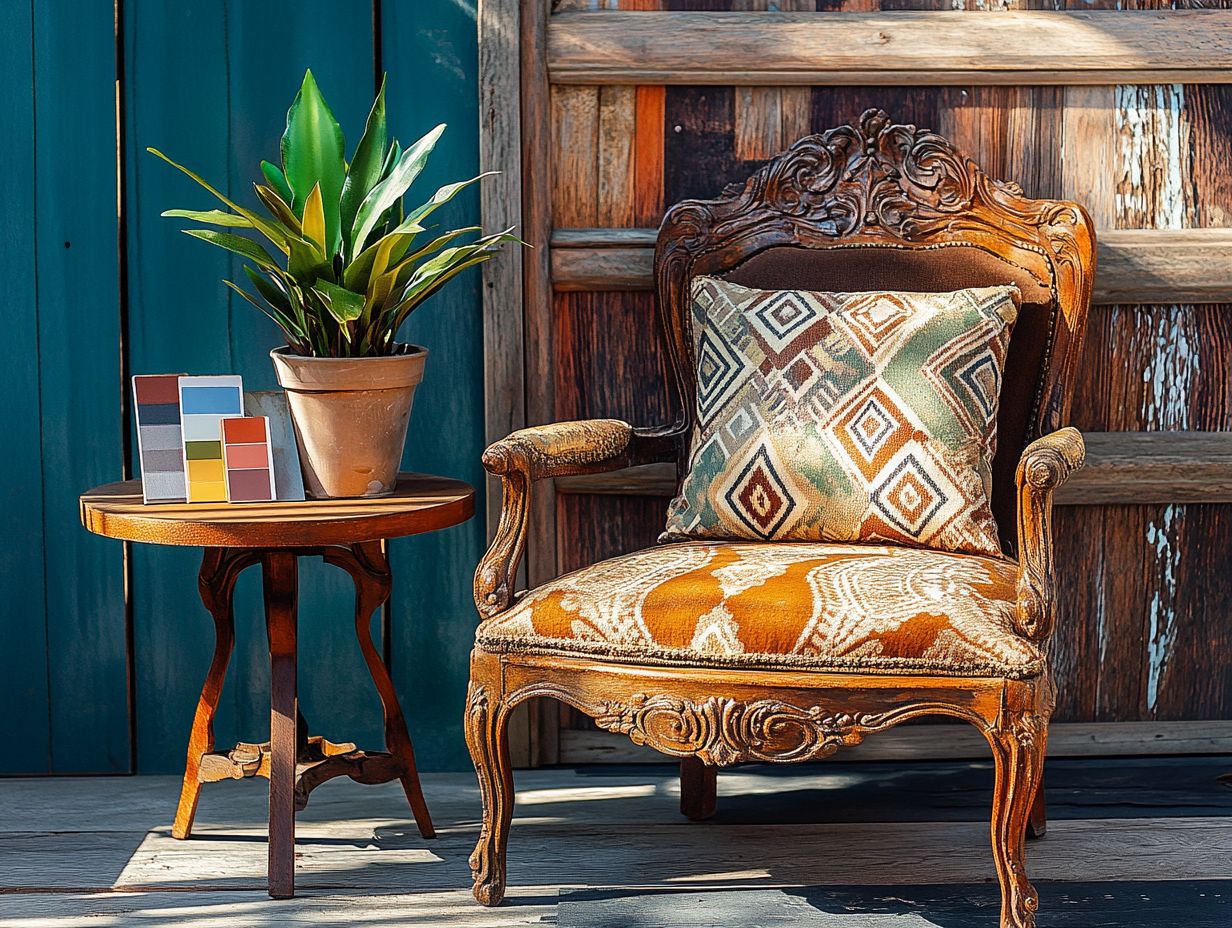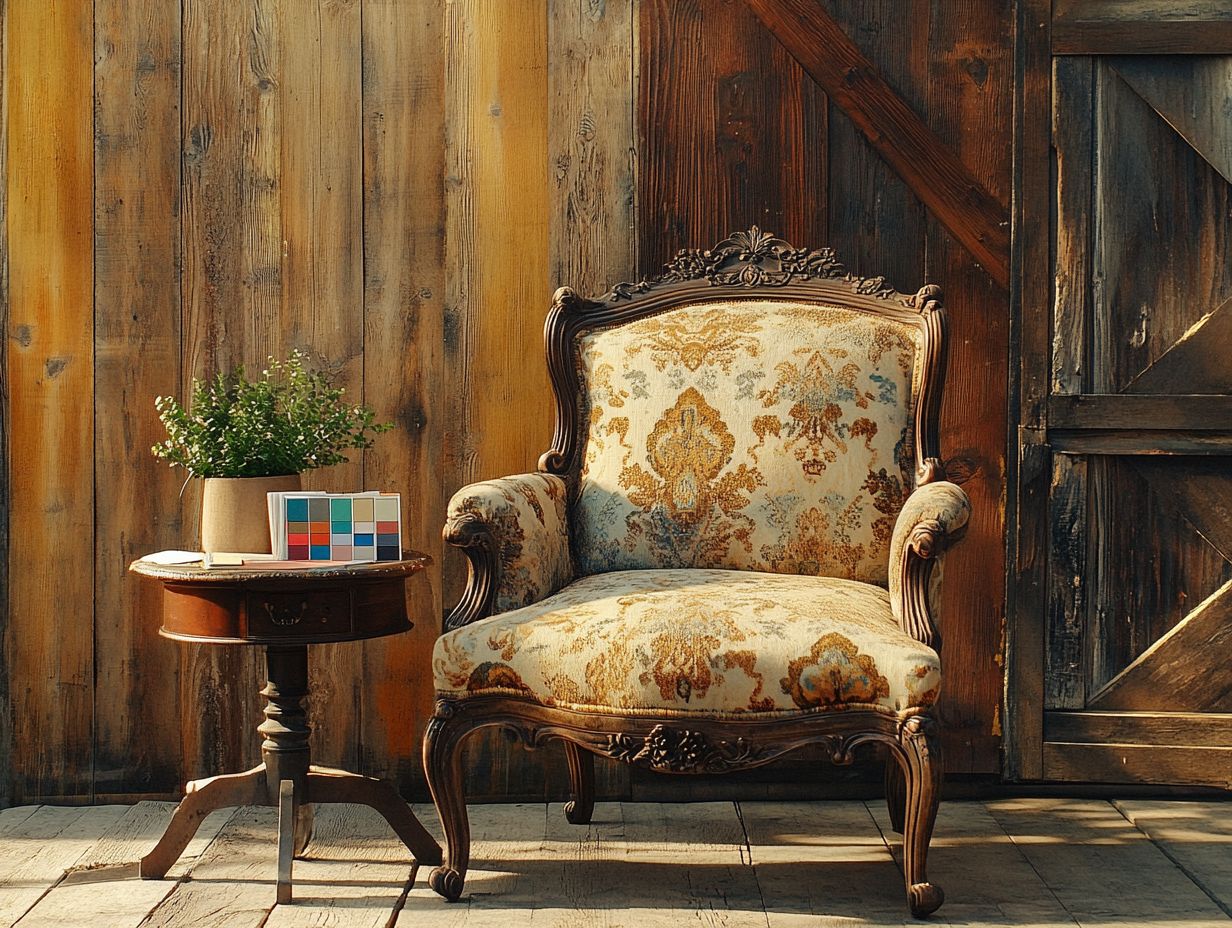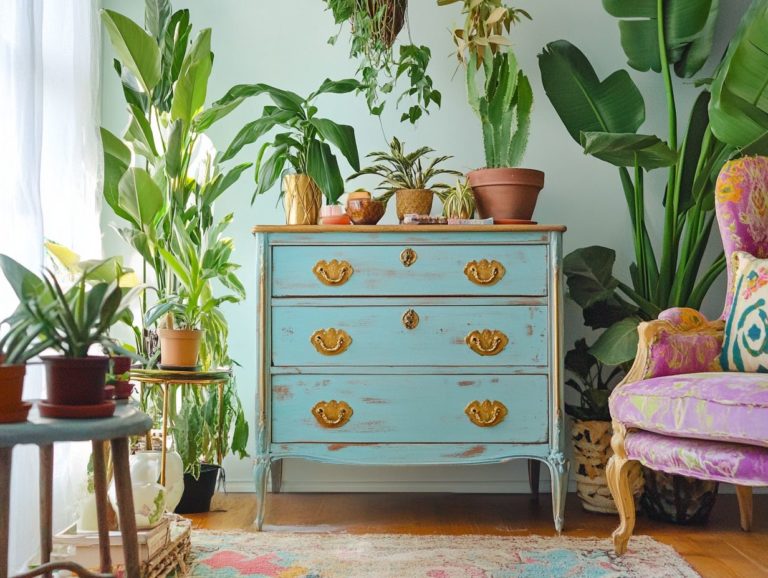Repurposing Vintage Furniture: A Creative Guide
Repurposing vintage furniture has emerged as a captivating trend that merges creativity with sustainability. This article invites you to explore the art of transforming old furniture into stylish, functional additions for your home. With creative ideas and innovative solutions, you can turn old pieces into new items.
Inside, you ll find guidance on selecting the right furniture for your DIY projects. We ll also provide a rundown of essential tools and materials. Unique ideas are sprinkled throughout to inspire you, ensuring an enjoyable and creative process.
You will discover a step-by-step guide designed to help your project unfold seamlessly. We also include valuable tips for maintaining your newly revitalized treasures to ensure they stand the test of time and reduce furniture waste.
Jump in and discover amazing secrets to breathe new life into your vintage treasures! By upcycling, you can create custom decor that reflects your style.
Contents
- Key Takeaways:
- Choosing the Right Furniture to Repurpose for Your DIY Projects
- Tools and Materials Needed for Repurposing
- Creative Ideas for Repurposing Vintage Furniture
- Are you ready to transform your old furniture into something breathtaking? Let s explore how!
- Step-by-Step Guide to Repurposing Furniture
- Maintenance and Care for Repurposed Furniture and Upcycling
- Common Questions on Upcycling and Repurposing
- 1. What is repurposing vintage furniture and why should I consider it for my home decor?
- 2. What are some popular ways to repurpose vintage furniture?
- 3. Do I need to have a lot of DIY experience to repurpose vintage furniture, or can I start with beginner projects?
- 4. Where can I find vintage furniture or other materials to repurpose?
- 5. How do I know if a piece of vintage furniture is suitable for repurposing or restoration?
- 6. Can I use modern materials, such as metal frames or polyurethane foam, to repurpose vintage furniture?
Key Takeaways:

- Repurposing vintage furniture is a popular trend that adds a unique touch to any home.
- Before starting a repurposing project, consider the style and condition of the furniture, along with your own skills and budget.
- Essential tools and materials, along with creative inspiration and step-by-step instructions, are key to successfully repurposing vintage furniture.
What is Repurposing and Why is it Popular?
Repurposing is your ticket to transforming old furniture into stunning new items that serve multiple purposes, all while supporting eco-friendliness and creativity. This innovative practice has surged in popularity, driven by a growing awareness of environmental stewardship and the quest for distinctive home d cor solutions. By upcycling old furniture which means giving new life to old items instead of throwing them away you reduce waste while crafting custom pieces that reflect your personal style.
The rise of DIY culture has only accelerated this movement. It inspires individuals like you to tap into your artistic instincts and see potential where others might overlook it. Repurposing doesn t just extend the life cycle of materials; it fosters a deeper connection to your belongings.
Imagine transforming an old dresser into a chic storage bench or converting pallets into stylish garden furniture. These projects offer both aesthetic appeal and practical solutions. Together, they divert waste from landfills, making a positive impact on the planet while infusing your living space with a personal touch.
Choosing the Right Furniture to Repurpose for Your DIY Projects
Selecting the right furniture for repurposing is vital for crafting a successful and imaginative transformation. Consider several factors that will impact your project, such as the furniture’s condition, style, and materials, including recycled steel and wood frames all of which play a significant role in its upcycling potential.
Venturing into thrift shops or recycling facilities can reveal a hidden trove of vintage gems waiting for your creative touch. Whether you re envisioning an old dresser as a chic bathroom vanity or transforming a wooden coffee table into a stylish kitchen island, the right piece can elevate the ordinary into a striking functional art statement.
Get started today and let your creativity shine! Share your repurposing successes with us!
Factors to Consider
When selecting old furniture to repurpose, it s essential to evaluate the materials, style, and condition for a successful DIY project. Each piece of furniture has its own story, and exploring its history can ignite your creative spark for transformation.
For instance, a vintage wooden frame might inspire that rustic charm you re after, while recycled steel components can introduce a sleek, modern industrial flair. This allows you to explore various styles for your home d cor.
The strength of your chosen piece is important; it dictates whether the item can endure daily life after restoration. Picture this: a sturdy oak table can be transformed into a stunning dining centerpiece, whereas flimsy particle board might leave you scrambling for reinforcements.
Don t overlook the upholstery either! Choosing durable fabrics can significantly enhance the longevity of your creation. A vibrant array of colors and patterns can breathe new life into the overall aesthetic, especially when using vibrant upholstery or fabric scraps.
These considerations guide you toward a project that fulfills your vision while honoring the essence of the original furniture.
Tools and Materials Needed for Repurposing

Having the right tools and materials is crucial for a fun and successful repurposing adventure! This sets the stage for seamless transformations from old furniture into stunning new pieces.
Key supplies include:
- basic tools like saws, hammers, and paintbrushes
- materials such as recycled steel, wooden frames, and upholstery fabric scraps
These elements streamline your creative process and enable you to craft innovative solutions that beautifully blend functionality with aesthetic charm.
Essential Supplies and Equipment
Essential supplies for your repurposing projects include tools and materials key to transforming old furniture into stylish, functional designs. When starting these creative endeavors, having the right inventory can significantly impact your results.
As a beginner, start with basic hand tools like:
- screwdrivers
- pliers
- a saw
These will set the foundation for your projects. Power tools, like a drill and sander, can elevate your efficiency. Remember to use Safety gear gloves, goggles, and a dust mask to shield yourself from potential hazards.
Opt for non-toxic paints and eco-friendly finishes to promote sustainability in your projects. They not only revitalize old pieces but also prioritize your health. If you’re budget-conscious, check out thrift stores and garage sales for raw materials; they are treasure troves for amazing finds!
This makes it an accessible and rewarding hobby for anyone ready to unleash their creativity!
Creative Ideas for Repurposing Vintage Furniture
Exploring creative ideas for repurposing vintage furniture unveils a world of possibilities that allows you to infuse your personal style into unique projects, enhancing your home decor.
How about transforming a vintage dresser into a chic bathroom vanity? Or converting an old wooden hall tree into a distinctive storage solution? The potential for furniture transformation is limited only by your imagination.
Embracing the upcycling trend nurtures your creativity and showcases your commitment to environmental sustainability. By minimizing furniture waste and supporting recycling facilities, you make a positive impact!
Are you ready to transform your old furniture into something breathtaking? Let s explore how!
Examples and Inspiration
Finding inspiration can be the secret ingredient to launching your next successful DIY project. Exploring various examples of upcycled vintage furniture and creative changes is sure to ignite your creativity. Platforms like Pinterest, Instagram, and YouTube are treasure troves where DIY enthusiasts share their amazing transformations. Think of transforming a vintage toy chest into a chic pet bed or repurposing old kitchen islands as stunning lighting fixtures.
These platforms showcase both stunning final results and the process behind them. For instance, you might come across creators who meticulously document how they sanded down and refinished a weathered rocking chair, breathing new life into it through projects like upcycling vintage chairs. Others illustrate the clever conversion of an old dresser into a stylish bathroom vanity.
By looking into these changes, you can uncover the thought processes behind selecting specific colors, materials, and tools. This can ignite your own passion for creativity. Whether you re aiming to refresh your living space or craft functional art pieces, these examples offer a wealth of ideas and inspiration for your next undertaking.
Step-by-Step Guide to Repurposing Furniture

Get ready to dive into a fun step-by-step guide to repurposing furniture! This offers you a clear roadmap, whether you’re a novice or a seasoned DIY enthusiast eager to transform your pieces into functional works of art. This meticulously structured approach ensures that each project unfolds with both efficiency and creativity.
You can find detailed instructions on selecting the project, sourcing the right materials, and executing the transformation process seamlessly. For those interested in furniture restoration, following this step-by-step guide not only nurtures your creativity but also builds your confidence throughout the journey.
Instructions and Tips for a Successful Project
To ensure your project is a resounding success, following clear instructions and incorporating handy tips can significantly elevate your furniture transformation experience. Preparing your workspace, gathering the necessary tools, and maintaining a flexible mindset are essential elements of any DIY venture.
From mastering painting techniques to exploring upholstery methods, each step plays a vital role in the final outcome, allowing your creativity to shine.
Before diving into the transformation, take a moment to thoroughly evaluate your piece of furniture. Assess its structure and material while identifying any potential issues that might arise down the line.
A practical tip is to sketch out a plan; this can guide your workflow and help you avoid unnecessary delays. Adaptability is key; sometimes your original vision may need a little tweaking in response to how materials react or when unforeseen challenges pop up.
For instance, when you sand or paint, choosing the right grit and allowing ample drying time can truly make a difference. Embracing your creativity during these moments can lead to unique solutions, transforming potential setbacks into innovative design features.
Maintenance and Care for Repurposed Furniture and Upcycling
Proper maintenance and care for repurposed furniture are essential to preserving the beauty and functionality of these unique creations. This ensures they remain cherished pieces in your home for years to come.
Regular upkeep not only enhances the lifespan of your DIY projects but also maintains their aesthetic appeal. This allows your creative investments to shine throughout your home decor.
Whether you re treating wood surfaces, cleaning upholstery, or protecting against wear and tear, incorporating maintenance practices is crucial. Act now! Your repurposed treasures deserve the best care to last for years!
How to Keep Your Repurposed and Upcycled Pieces Looking Great
Maintaining your repurposed pieces involves a thoughtful blend of regular upkeep and careful attention tailored to the materials you ve transformed. Simple practices, like dusting, conditioning wooden surfaces, and using fabric protectants, will help your creations last longer and look stunning while preserving their original charm.
To keep things looking sharp, consider using natural oils oils derived from plants that nourish wood on wooden surfaces to enhance their shine and protect against wear. For upholstered items, establishing a regular vacuuming routine will help eliminate dust and prevent fabric deterioration. This ensures those vibrant colors stay bright and beautiful over time.
For painted surfaces, a gentle cleaning solution and the occasional touch-up will keep the finish looking fresh and inviting. Don t overlook the small details, like placing coasters under drinks and pads under vases. These simple steps can prevent unsightly marks and scratches.
Small, consistent actions can significantly impact the longevity and visual appeal of your delightful creations. Start today and enjoy your unique creations for years to come!
Common Questions on Upcycling and Repurposing

1. What is repurposing vintage furniture and why should I consider it for my home decor?
Repurposing vintage furniture involves transforming old or outdated pieces into functional, stylish items that can be used in modern homes. It is a great way to breathe new life into old pieces and reduce waste. Plus, it allows you to create unique and personalized items for your home.
2. What are some popular ways to repurpose vintage furniture?
- Painting and distressing
- Adding new hardware
- Reupholstering
- Turning a dresser into a kitchen island
3. Do I need to have a lot of DIY experience to repurpose vintage furniture, or can I start with beginner projects?
While some repurposing projects require advanced skills, there are plenty of beginner-friendly ideas anyone can try. With some basic tools and a little creativity, you can successfully repurpose vintage furniture without any prior DIY experience.
4. Where can I find vintage furniture or other materials to repurpose?
You can find vintage furniture at thrift stores, flea markets, garage sales, and even online marketplaces. It’s always a good idea to keep an eye out for unique pieces that have the potential to be repurposed.
5. How do I know if a piece of vintage furniture is suitable for repurposing or restoration?
When looking for furniture to repurpose, consider its condition and structure. Pieces with sturdy frames and solid construction are ideal for repurposing. It’s also important to think about your vision for the piece and how it will fit into your home.
6. Can I use modern materials, such as metal frames or polyurethane foam, to repurpose vintage furniture?
Absolutely! Using modern materials can often make the repurposed piece more functional and durable. Just be sure to choose materials that complement the vintage aesthetic and do not damage the original piece.





